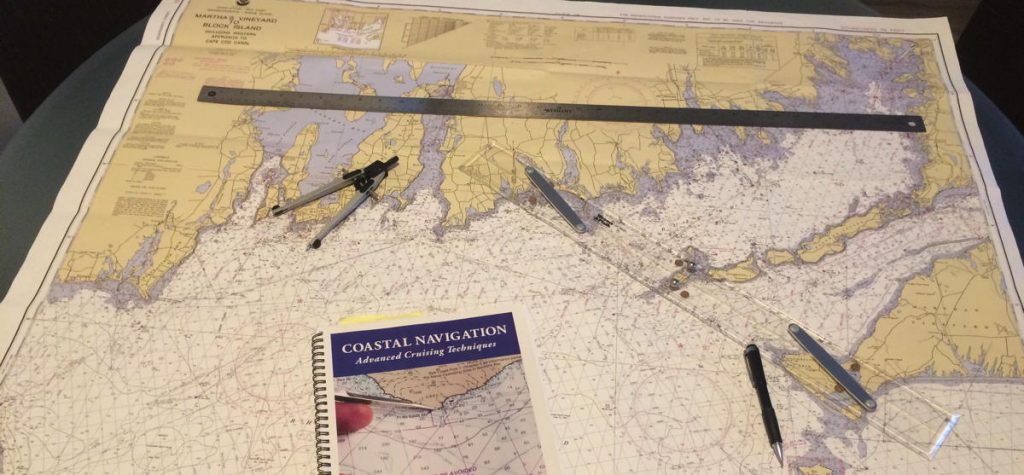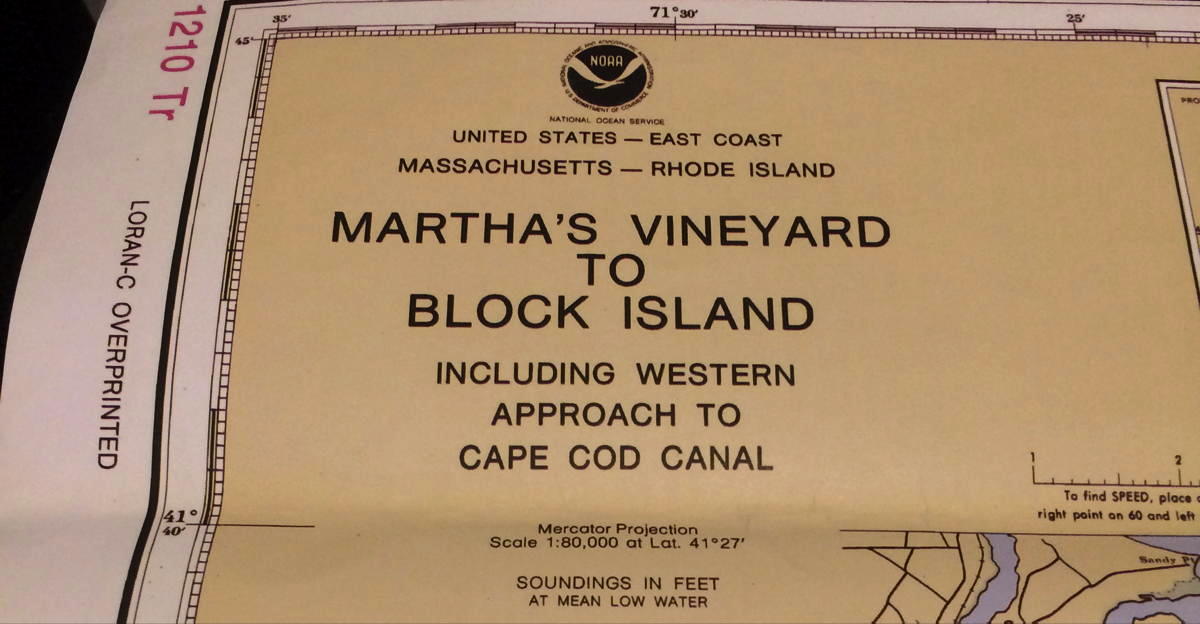
If you’re thinking of taking the 105 Coastal Navigation class this post may help. I passed the exam recently and thought I’d write about it, since I’d felt a lot of anxiety leading up to it. They say it’s one of the most difficult ASA exams, and it certainly was the most challenging for me so far! Here are some pointers and thoughts to help you prepare and hopefully ace the exam!

Classroom or Home Study?
There are a couple of different ways to take ASA 105. You can find a formal class to attend, but at the time that wasn’t available for me. I did a home study course offered by my local sailing school. The course was based around the book Coastal Navigation by Captain Mike Pyzel which comes with a CD-ROM study guide pdf and a large format chart 1012TR of Martha’s Vineyard to Block Island. I got one chart to practice with and another chart was waiting at the school’s office with the exam for me to take.
I really liked that with the home study format I could learn at my own pace. However, having a bit of a time limit or schedule might have helped me get moving and take the exam sooner. If you have the opportunity to take a formal class with an instructor I’d recommend that, so you can ask questions when you don’t fully understand something. With the home study course the only way to master the material is to use the book’s practice questions at the end of each chapter. The answers are given in the back. Captain Pyzel explains things well, but I had to read the chapters repeatedly so as not to miss little bits of information needed to fully understand the material.
Navigation Charting Tips
You’re going to need dividers, parallel rules, a mechanical pencil and a big eraser. When working with the big chart I recommend using the 24″ Weems and Plath parallel ruler and not the smaller 15″ version. When practicing the chart plotting questions my accuracy was much better using the longer 24″ parallel ruler. Also, some of the practice questions required me to use a 36″ ruler, as the parallel rules were not long enough to draw the course in one shot without repositioning. Practicing the chart plotting several times really helped me improve my accuracy. Make sure to write the magnetic course, distance and speed information along your course lines so the instructor can easily follow and understand what you’ve done.
When you’re plotting the courses, sometimes it can feel unclear whether your parallel rules are lined up in the right place over the compass rose. On the exam you can only be off by one degree in either direction or you’ll lose points and might fail the test. One thing that helped me was to use all four degree marks on the compass rose. What I mean is, maybe I’m only interested in the inner magnetic circle of the compass rose in the direction I’m heading, but I would still line up the parallel rules on the forward, reverse and true marks as well. The true circle is larger than the magnetic one, so lining the parallel rules up across it while making sure I’m on the correct magnetic markings really helped ensure I was lined up as well as possible over the compass rose.
Tips to Ace the ASA 105 Exam
• Memorize the U.S. Aids to Navigation page in the back of Captain Pyzel’s book.
• When asked to identify something, write as much detail as possible.
• Know all the details in the Summary of Buoyage in U.S. on page 2-6 of Pyzel’s book.
• When plotting courses write distance, MC and speed information along the course.
• Understand tides and currents inside out since these questions are worth many points.
• Be accurate charting the courses within 1 degree in either direction.
If you do the Pyzel practice questions multiple times until you don’t get any wrong, you should be able to pass within the allowed 80% or higher. Don’t rush! The beauty of a home study course is you can spend weeks or even months absorbing the material. When you finish the 105 exam questions, use your remaining time to double check your answers.
Leave a comment below to ask a question or let me know how the ASA 105 exam went for you!

I recently passed the ASA 106 and I would like to mention that the instructor had us apply all of the concepts from 105 such as: danger bearing, running fixes, aids to navigation and so on. I personally enjoyed it but I think it would be great practice even for 105 to get a local chart and during a day sail work similar problems as the sample Pyzel problems, this would help not only with the exam but also understand how powerful this navigation knowledge is. Great work Steve.
Great info re ASA 105. I’m about to take a 10-week class offered by the coast guard that will cover basic to advanced navigation. Since I feel pretty weak in this area, this will be helpful, so when I finally take ASA 105, I will be ready! Thanks, Steve